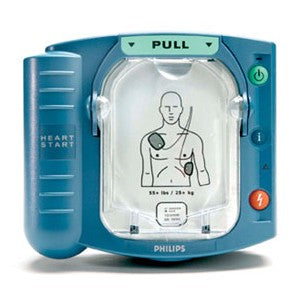AED Special Considerations
Canadian Red Cross AED Protocol: Special Situations

Infants and Children
Cardiac Arrest in infants and children mainly results from respiratory failure, not cardiac failure. The priority is to establish and maintain a clear airway and provide breathing and circulation. AEDs may be used on children 1 to 8 years of age. Ideally, AEDs equipped with child electrode pads and cables should be used. If child electrode pads are not available, you may use adult electrode pads. Follow manufactures' directions for paediatric pad placement.
Transdermal Medications
AED electrodes should not be placed over a transdermal medication patches (e.g., a patch of nitroglycerin, nicotine, pain medication, hormone replacement therapy, or antihypertensive medication) as the patch may block the transfer of the energy to the heart and may cause small burns to the skin. With a gloved hand, remove any patches from the chest and wipe the area before attaching the electrode pads.
Implanted Pacemakers and implanted Cardioverter-Defibrillators
The casualty may have a pacemaker or implanted cardioverter-defibrillator (ICD) implanted in the chest area where one of the electrode pads is intended to go. If you observe a small scar and a matchbox-size lump on the chest, reposition the electrodes at least 2.5 cm (1 inch) away. If an ICD is already in shock sequence (e.g., the patient's muscles contract in a manner similar to that observed during external defibrillation), allow 30 to 60 seconds for the ICD to complete the treatment cycle before delivering a shock from the AED.
Single Rescuer
In some situations, one rescuer with immediate access to an AED may respond to a cardiac arrest. The rescuer should quickly summon more advanced medical personnel. A single lay rescuer or targeted responder should confirm the cardiac arrest, attach the AED, and follow the standard defibrillation protocol.
Health Care Providers (HCP) rescuers should provide 2 minutes of CPR before attaching the AED.
Unwitnessed vs witnessed for HCP only
If unwitnessed, perform 2 minutes of CPR before placing the AED on the person. If witnessed arrest, activate AED as soon as possible.
Body Jewellery
If necklaces or other body jewellery is in the way or within 1 inch of electrode pad placement, remove the jewellery before AED use.
Trauma Casualties
Place electrode pads on the chest if the trauma does not interfere with the placement.
Electrode Placement
Rescuers should place AED electrode pads on the victim's bare chest in the conventional sternalapical (anterolateral) position . The right (sternal) chest pad is placed on the victim's right superioranterior (infraclavicular) chest and the apical (left) pad is placed on the victim's inferior-lateral left chest, lateral to the left breast. Other acceptable pad positions are placement on the lateral chest wall on the right and left sides (biaxillary) or the left pad in the standard apical position and the other pad on the right or left upper back. Always consult with your AED manufacturer to confirm suggested palcement for a specific machine
Pregnancy
No modification to AED protocol.
Ice, Snow and Water
No change in protocol for ice and snow. If the person is lying in a puddle or other pool of water, do the "splash test". If you jump in the water and it splashes, it is deep enough to conduct an electrical charge, so you must remove the person from the water before you use the AED.
Oxygen
Keep breathing devices with free-flowing oxygen away from the person during defibrillation.
Hypothermia
Only deliver one shock then continue CPR.
Obvious signs of death
In the cases of decapitation, rigour mortis and trans-section, CPR / AED does not need to be initiated.
Choking
No change to protocol. Clear the airway prior to initiating the AED protocol.
Vomiting
Clear the airway and continue.
